![Brotzmann, Peter / Fred Van Hove / Han Bennink: Jazz in der Kammer Nr.71 [VINYL 2 LPs] (Trost Records) Brotzmann, Peter / Fred Van Hove / Han Bennink: Jazz in der Kammer Nr.71 [VINYL 2 LPs] (Trost Records)](https://www.teuthida.com/productImages/misc4/32167.jpg)
Recorded for radio for the series Jazz in der Kammer Nr 71, this 1974 concert was the first in East Germany for Peter Brötzmann, Fred Van Hove, and Han Bennink, bridging the divided German states through an energetic set of improvisations that extended traditional jazz with outrageous approaches to improv in an exciting, quirky and profoundly masterful set of European Free Jazz.
Out of Stock
Quantity in Basket: None
Log In to use our Wish List
Shipping Weight: 34.00 units
Sample The Album:
Peter Brotzmann-tenor saxophon, clarinet
Fred Van Hove-piano
Han Bennink-drums, percussion
Click an artist name above to see in-stock items for that artist.
UPC: 9120036683587
Label: Trost Records
Catalog ID: TROST 222LP
Squidco Product Code: 32167
Format: 2 LPs
Condition: New
Released: 2022
Country: Austria
Packaging: Double Vinyl 12" Gatefold Sleeve
Recorded at Deutsches Theater, in Berlin, Germany, on November 4th, 1971.
"In 1971, the Kammerspiele of the Deutsches Theater in Berlin-Mitte were located in what was then East Berlin, not far from the Berliner Ensemble, Bertolt Brecht's theater, and only a few minutes away from the Friedrichstraße border crossing, the checkpoint for incoming visitors from the West but the final stop for GDR citizens, which is why the place was also called the palace of tears. The overall atmosphere in the city at that time can be described as heated, the political mood between the two German states was tense. However, those were also musically raucous times. In 1968, Wuppertal saxophonist and clarinetist Peter Brötzmann formed a trio with Antwerp pianist Fred Van Hove and Dutch percussionist and multi-instrumentalist Han Bennink, marking the transition from the power phase of European improvised jazz of the larger formations (e.g. his Machine Gun octet) to more sophisticated but still energetic playing in smaller lineups. The trio's concert in East Berlin was Brötzmann's first "official" concert in the GDR (there had been a few unofficial encounters before) and the audience vibrated with excitement and anticipation. Now, on the basis of this sound document, one can listen to how the three musicians made the air burn.
Jazz in der Kammer No. 71 is a contemporary document of this second initial spark in European free jazz. Conventional "jazz rules" were still broken, but especially sound was redefined in the process. Brötzmann, Van Hove and Bennink moved away from the boisterous outcries of early European free jazz and discovered the quiet, delicate sides of their instruments. They gave free rein to their ideas, tamed only by few agreements: spontaneous music, linked with humorous interludes and excessive atonality. The variety and density, structure, fine dynamics and musical microcosms of this music are still surprising - even after more than 50 years. A rich, musical world unfolds that has not taken on any patina.
For Jazz in the Chamber no. 71 offers everything that one has come to love on the nine albums released so far by this trio (if you count the four with trombonist Albert Mangelsdorff as well): The clash of different creative means, Peter Brötzmann's expressive spectrum from primal screams to the most delicate, softest breaths, as well as his drones on the baritone saxophone reminiscent of foghorns; Han Bennink's instrumental variety through the use of his home made junk (exotic drums and rattles and unconventional instruments); but especially Fred Van Howe's energetic, ultra-fast trills, his oddballness, the folk songs he likes to intersperse, and his Taylor-like cascades, which, when combined with Bennink's attacks on cymbals and snare, make one think of barrages. Brötzmann himself is rather restrained by his standards, which brings Van Hove more to the fore compared to other recordings, since in the past he often threatened to be drowned in the saxophonist's and Bennink's storm of steel. As a result, the basically highly condensed music gains more space, humor loosens the tension, and unusual techniques and stylistic elements are integrated into the musical events in an almost collage-like manner.
These live recordings are already one of the finest reissues in 2022 jazz (along with Albert Ayler's Revelations - The Complete ORTF 1970 Fondation Maeght Recording and Charles Mingus's The Lost Album from Ronnie Scott's). This band's music is so radically democratic, technically sophisticated and musically pleasurable that after listening to the album you want to start over again and again. The striving for openness, contrast and structural clarity is also evident in the fact that there is plenty of room for solos and duets - also to Van Hove's advantage. The musicians, for all their lack of agreement, have such a sense of cohesion, such a frenzy of quotation, that it seems the music is being put through the meat grinder of their imagination. The repertoire of sounds and techniques, the density and pace of development of the events and the wit of this music have no equal to this day."-Martin Schray
Artist Biographies
• Show Bio for Peter Brotzmann "Born Remscheid, Germany on 6 March 1941; soprano, alto, tenor, baritone and bass saxophones, a-clarinet, e-flat clarinet; bass clarinet, tarogato. Peter Brötzmann's early interest was in painting and he attended the art academy in Wuppertal. Being very dissatisfied with the gallery/exhibition situation in art he found greater satisfaction playing with semi-professional musicians, though continued to paint (as well as retaining a level of control over his own records, particularly in record sleeve/CD booklet design). In late 2005 he had a major retrospective exhibition jointly with Han Bennink - two separate buildings separated by an inter-connecting glass corridor - in Brötzmann's home town of Remscheid. Self-taught on clarinets, he soon moved to saxophones and began playing swing/bebop, before meeting Peter Kowald. During 1962/63 Brötzmann, Kowald and various drummers played regularly - Mingus, Ornette Coleman, etc. - while experiencing freedoms from a different perspective via Stockhausen, Nam June Paik, David Tudor and John Cage. In the mid 1960s, he played with American musicians such as Don Cherry and Steve Lacy and, following a sojourn in Paris with Don Cherry, returned to Germany for his unorthodox approach to be accepted by local musicians like Alex von Schlippenbach and Manfred Schoof. The trio of Peter Brötzmann, Peter Kowald and Sven-Ake Johansson began playing in 1965/66 and it was a combination of this and the Schoof/Schlippenbach Quintet that gave rise to the first Globe Unity Orchestra. Following the self-production of his first two LPs, For Adolphe Sax and Machine gun for his private label, BRÖ, a recording for Manfred Eicher's 'Jazz by Post' (JAPO) [Nipples], and a number of concert recordings with different sized groups, Brötzmann worked with Jost Gebers and started the FMP label. He also began to work more regularly with Dutch musicians, forming a trio briefly with Willem Breuker and Han Bennink before the long-lasting group with Han Bennink and Fred Van Hove. As a trio, and augmented with other musicians who could stand the pace (e.g. Albert Mangelsdorff on, for example, The Berlin concert), this lasted until the mid-1970s though Brötzmann and Bennink continued to play and record as a duo, and in other combinations, after this time. A group with Harry Miller and Louis Moholo continued the trio format though was cut short by Miller's early death. The thirty-plus years of playing and recording free jazz and improvised music have produced, even on just recorded evidence, a list of associates and one-off combinations that include just about all the major figures in this genre: Derek Bailey (including performances with Company (e.g. Incus 51), Cecil Taylor, Fred Hopkins, Rashied Ali, Evan Parker, Keiji Haino, Misha Mengelberg, Anthony Braxton, Marilyn Crispell, Andrew Cyrille, Phil Minton, Alfred 23 Harth, Tony Oxley. Always characterised as an energy player - and the power-rock setting of Last Exit with Ronald Shannon Jackson, Sonny Sharock and Bill Laswell, or his duo performances with his son, Casper, did little to disperse this conviction - his sound is one of the most distinctive, life-affirming and joyous in all music. But the variety of Brötzmann's playing and projects is less recognised: his range of solo performances; his medium-to-large groups and, in spite of much ad hoc work, a stability brought about from a corpus of like- minded musicians: the group Ruf der Heimat; pianist Borah Bergman; percussionist Hamid Drake; and Die like a dog, his continuing tribute to Albert Ayler, with Drake, William Parker and Toshinori Kondo. Peter Brötzmann continues a heavy touring schedule which, since 1996 has seen annual visits to Japan and semi-annual visits to the thriving Chicago scene where he has played in various combinations from solo through duo (including one, in 1997, with Mats Gustafsson) to large groups such as the Chicago Octet/Tentet, described below. He has also released a number of CDs on the Chicago-based Okka Disk label, including the excellent trio with Hamid Drake and the Moroccan Mahmoud Gania, at times sounding like some distant muezzin calling the faithful to become lost in the rhythm and power of the music. The "Chicago Tentet" was first organized by Brötzmann with the assistance of writer/presenter John Corbett in January 1997 as an idea for a one-time octet performance that included Hamid Drake and Michael Zerang (drums), Kent Kessler (bass) and Fred Lomberg-Holm (cello), Ken Vandermark and Mars Williams (reeds), and Jeb Bishop (trombone). The first meeting was extremely strong and warranted making the group an ongoing concern and in September of that same year the band was expanded to include Mats Gustafsson (reeds) and Joe McPhee (brass) as permanent members (with guest appearances by William Parker (bass), Toshinori Kondo (trumpet/electronics), and Roy Campbell (trumpet) during its tenure) - all in all a veritable who's who of the contemporary improvising scene's cutting edge. Though the Tentet is clearly led by Brötzmann and guided by his aesthetics, he has been committed to utilizing the compositions of other members in the ensemble since the beginning. This has allowed the band to explore an large range of structural and improvising tactics: from the conductions of Mats Gustafsson and Fred Lonberg-Holm, to the vamp pieces of Michael Zerang and Hamid Drake, to compositions using conventional notation by Ken Vandermark and Mars Williams, to Brötzmann's graphic scores - the group employs almost every contemporary approach to composing for an improvising unit. This diversity in compositional style, plus the variety in individualistic approaches to improvisation, allows the Tentet to play extremely multifaceted music. As the band moves from piece to piece, it explores intensities that range from spare introspection to all out walls of sound, and rhythms that are open or free from a steady pulse to those of a heavy hitting groove. It is clear that the difficult economics of running a large band hasn't prevented the group from continuing to work together since its first meeting. Through their effort they've been able to develop an ensemble sound and depth of communication hard to find in a band of any size or style currently playing on the contemporary music scene." ^ Hide Bio for Peter Brotzmann • Show Bio for Fred Van Hove Fred Van Hove: "Born 1937 in Antwerp, Belgium; piano, accordion, church organ, composer. Fred Van Hove studied piano, theory and harmony at the Music Academy in Belgium and experimented with several jazz styles and dance music before making the transition to free improvisation with local musicians (Zinzen, Van De Ven and Wanders). He has been a professional free-lance musician since 1964. 1966 saw the beginning of Van Hove's collaboration with Peter Brötzmann, initially in quartet or larger groupings (eg Machine Gun), then stabilising in a trio format (with Han Bennink) for five to six years; in 1995 contact with Brötzmann was renewed when the two played a duo as part of the 'Pool' at the Free Music XXII in Antwerp in August. His first solo concerts were played at the Avant-garde festival Gravensteen, Ghent, in 1970 and Jazz Middleheim, in Antwerp in 1971. In 1972, working as a duo with Belgian sax player Cel Overberghe, he refused to play at the Middelheim festival as a result of a dispute over the grossly differential fees being paid to visiting American musicians on the one hand and European musicians on the other. This dispute led to the foundation of the musicians collective WIM vzw, Werkgroep Improviserende Musici, whose aim was to improve the situation of free music in Belgium. Fred Van Hove has been Chairman of WIM since then. From 1976, and in collaboration with, for example, De Andere Film Antwerp & Ghent, Dommelhof Neerpeilt (Belgium), and Filmhaus Berlin, he has provided solo accompaniment to silent movies, particularly experimental films of the 1920s (Griffiths, Porter, Murnau, Lang, Dreyer, among others) as well as comedies and animations. He has also performed regularly with duo partners who have included: Steve Lacy; Vinko Globokar; Lol Coxhill; Albert Mangelsdorf; Annick Nozati; Phil Wachsmann; André Goodbeek; Paul Van Gyseghem. From the end of the 1970s, Van Hove formed a number of groups utilising the initials MLA (Musica Libera Antverpiae) and MLB (Musica Libera Belgicae) or similar. The first MLA, formed in 1978, was a group of variable composition from a nucleus of seven musicians: three strings; three brass; piano. This undertook several tours and festivals (e.g. at Jazz Middelheim, and London). In 1979, MLA Blek comprised Marc Charig on trumpet and Radu Malfatti and Paul Rutherford on trombones and toured Italy. Formed in 1980, though recorded in 1982, the ML DD 4 consisted of Marc Charig, Phil Wachsmann and Günther 'Baby' Sommer on percussion and toured through several ex-DDR European countries. In 1983, Fred Van Hove was invited to Berlin by the DAAD (Deutscher Akademischer Austauschdienst) as artist in residence for six months, April to October. During this time he took the opportunity to play concerts with MLA, MLA Blek and ML DD 4, but also to play extensively with local musicians in a series of MLBB: Berliner Begegnungen or Berlin Encounters. In the mid-80s, Fred Van Hove undertook several tours of Japan playing solo and duos with a wide variety of musicians including percussionist Sabu Toyozumi, bass player Tetsu Saitoh; and US and European musicians such as: Ned Rothenberg; Douglas Ewart; Peter Kowald; Hans Reichel; Evan Parker; and Barry Guy. A three-day Van Hove festival was held at the concert hall Space Who, Saitama, celebrating its 5th anniversary. The Belgisch Pianokwartet was formed in 1984, four pianists at 2 grands, originally consisting of Walter Hus, Christian Leroy and Eddy Loozen, but more recently with Marilyn Crispell replacing Hus and the group name becoming 't Pianokwartet. The MLB III trio with André Goudbeek, saxophone, and Ivo Vander Borght, percussion was formed around the same time, recorded in 1988 and toured the former DDR (with trumpeter Andy Altenfeldert), Spain and the Netherlands. Since 1988 the trio with the French singer Annick Nozati and the German trombonist Johannes Bauer has recorded and toured and, from 1991, 't Nonet has performed, comprising: Marc Charig or Axel Dörner, trumpet; Annick Nozati, voice; Paul Rutherford and Johannes Bauer, trombones; Benoit Viredaz, tuba, Evan Parker or John Butcher and André Goudbeek, saxophones; and Ivo Vander Borght, percussion. Cooperation with other musicians has included Luc Houtkamp, Connie Bauer and Wolfgang Fuchs. Fred Van Hove has cooperated with poets and painters (the action painter W.J.C. Free) and held seminars and workshops on improvisation in Antwerp, Tilberg, Ghent, Amsterdam, in England and Germany and, since 1990, at Département d'Etudes Musicales, University Lille 3, France. In June 1996 the Belgium government conferred on Fred Van Hove the title of Cultural Ambassador of Flanders 1996, an award that included a grant for touring outside of Belgium." ^ Hide Bio for Fred Van Hove • Show Bio for Han Bennink "Drummer and multi-instrumentalist Han Bennink was born in Zaandam near Amsterdam in 1942. His first percussion instrument was a kitchen chair. Later his father, an orchestra percussionist, supplied him with a more conventional outfit, but Han never lost his taste for coaxing sounds from unlikely objects he finds backstage at concerts. He is still very fond of playing chairs. In Holland in the 1960s, Bennink was quickly recognized as an uncommonly versatile drummer. As a hard swinger in the tradition of his hero Kenny Clarke, he accompanied touring American jazz stars, including Sonny Rollins, Ben Webster, Wes Montgomery, Johnny Griffin, Eric Dolphy and Dexter Gordon. He is heard with Gordon on the 1969 album "Live at Amsterdam Paradiso" (on the Affinity label) and with Dolphy on 1964s "Last Date" (PolyGram). At the same time, Bennink participated in the creation of a European improvised music which began to evolve a new identity, apart from its jazz roots. With fellow Dutch pioneers, pianist Misha Mengelberg and saxophonist Willem Breuker, he founded the musicians collective Instant Composers Pool in 1967. Bennink anchored various bands led by Mengelberg or Breuker, and appeared in their comic music-theater productions. Bennink attended art school in the 1960s, and is also a successful visual artist in several media, often constructing sculpture from found objects, which may include broken drum heads and sticks. He has designed the covers for many LPs and CDs on which he appears. Bennink is represented by Amsterdam's Galerie Espace, and has been the subject of several one-man shows, including one at the Gemeente Museum in the Hague in 1995. In 1966, Bennink played the US's Newport Jazz Festival with the Mengelberg quartet. From the late 1960s through the '70s Bennink collaborated frequently with Danish, German, English and Belgian musicians, notably saxophonists John Tchicai and Peter Broetzmann, guitarist Derek Bailey and pianist Fred van Hove. Bennink, Broetzmann and van Hove had a longstanding trio well documented on FMP Records. There Bennink also showcased his talents on clarinet, trombone, soprano saxophone and many other instruments, also featured in a series of solo albums he began in 1971. Bennink's many recordings from the 1980s include sessions with Mengelberg's ICP Orchestra (where he remains), South African bassist Harry Miller, soprano saxophonist Steve Lacy, trombonists Roswell Rudd and George Lewis, and big-bandleaders Sean Bergin and Andy Sheppard. From 1988 to'98 Bennink's main vehicle was Clusone 3, with saxophonist and clarinetist Michael Moore and cellist Ernst Reijseger, a band noted for its free-wheeling mix of swinging jazz standards, wide-open improvising, and tender ballads. Clusone played Europe and North America, West Africa, China, Vietnam and Australia, and recorded five CDs for Gramavision, hat Art and Ramboy. Nowadays he is frequently heard with tenor saxophonist Tobias Delius's quartet and in a trio with pianist/keyboardist Cor Fuhler and bassist Wilbert de Joode, and he still collaborates occasionally with jazz luminaries such as Johnny Griffin, Von Freeman and Ray Anderson. A conspicuous feature of Bennink's musical life since the 1960s is the spontaneous duo concert with musicians of many nationalities and musical inclinations; in the '90s he recorded in duo with among others pianists Mengelberg, Irene Schweizer and Myra Melford, guitarist Eugene Chadbourne, trumpeter Dave Douglas and tenor saxophonist Ellery Eskelin. Since 2008 Han Bennink has his own Han Bennink Trio consisting of Han Bennink, Joachim Badenhorst on clarinet and Simon Toldam on piano." ^ Hide Bio for Han Bennink
11/20/2024
Have a better biography or biography source? Please Contact Us so that we can update this biography.
11/20/2024
Have a better biography or biography source? Please Contact Us so that we can update this biography.
11/20/2024
Have a better biography or biography source? Please Contact Us so that we can update this biography.
Track Listing:
SIDE A
1. Schwarzspecht (14:12)
2. Filet Americain (8:02)
SIDE B
1. Der Mammutzahn aus Balve (18:34)
SIDE C
1. Boogie Fuer Fred (22:16)
SIDE D
1. Serieuze Serie (9:37)
2. Involved (7:13)
Vinyl Recordings
Improvised Music
Jazz
Free Improvisation
European Improvisation, Composition and Experimental Forms
Peter Brotzmann
Trio Recordings
Staff Picks & Recommended Items
New in Improvised Music
Recent Releases and Best Sellers
Search for other titles on the label:
Trost Records.


![Brotzmann, Peter / Fred Van Hove / Han Bennink: Jazz in der Kammer Nr.71 [VINYL 2 LPs] (Trost Records) Brotzmann, Peter / Fred Van Hove / Han Bennink: Jazz in der Kammer Nr.71 [VINYL 2 LPs] (Trost Records)](https://www.teuthida.com/productImages/full/32167.Full.jpg)

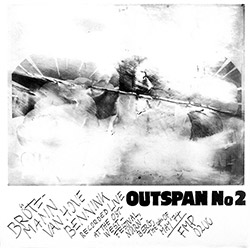
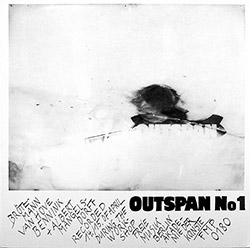






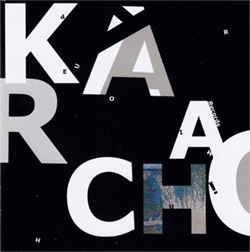


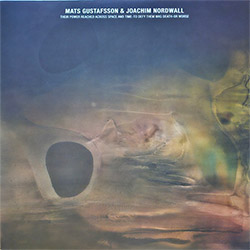


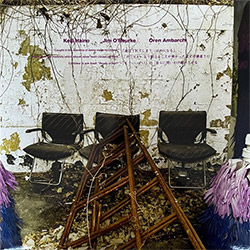
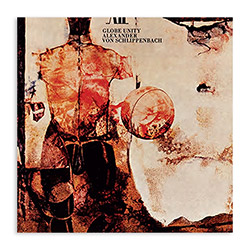
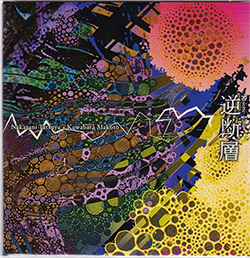
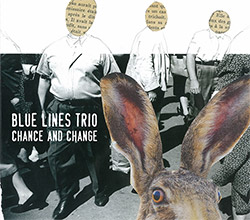
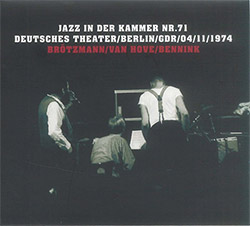

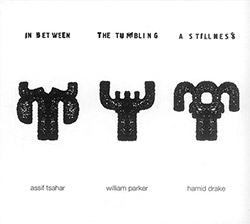
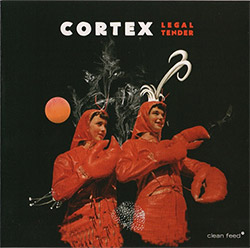

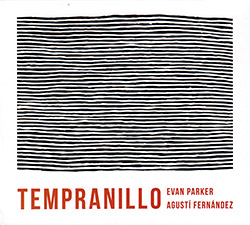



![Guy, Barry / Ken Vandermark: Occasional Poems [2 CDs]](https://www.teuthida.com/productImages/misc4/34849.jpg)
![Novoa / Carter / Mela Trio: Vol.1 [VINYL]](https://www.teuthida.com/productImages/misc4/35236.jpg)


![Elephant9 : Mythical River [VINYL]](https://www.teuthida.com/productImages/misc4/34624.jpg)
![Evans, Peter (Evans / Eldh / Black): Extra [VINYL]](https://www.teuthida.com/productImages/misc4/35279.jpg)

![McPhee, Joe: Straight Up, Without Wings [BOOK]](https://www.teuthida.com/productImages/misc4/35454.jpg)
![Jeck, Philip: rpm [2 CDs]](https://www.teuthida.com/productImages/misc4/35455.jpg)













![Barker / Parker / Irabagon: Bakunawa [VINYL]](https://www.teuthida.com/productImages/misc4/35533.jpg)
![Blaser, Samuel / Marc Ducret / Peter Bruun: Dark Was The Night, Cold Was The Ground [VINYL 10-inch]](https://www.teuthida.com/productImages/misc4/35492.jpg)








![Warren, Kenny (Warren / Hoffman / Ellman): Sweet World [VINYL]](https://www.teuthida.com/productImages/misc4/35451.jpg)




![Blake, Ran / Dave Knife Fabris: Live Amsterdam 2006, First Visit [CD + POSTCARDS]](https://www.teuthida.com/productImages/misc4/35275.jpg)













![DNS: Taking Big Bites Of The Khandas Three Cafes Deep [2 CDs]](https://www.teuthida.com/productImages/misc4/35334.jpg)




![Cleaver, Gerald: The Process [VINYL]](https://www.teuthida.com/productImages/misc4/34966.jpg)




![Alva Noto: HYbr:ID II [VINYL 2 LPs]](https://www.teuthida.com/productImages/misc4/35201.jpg)

![Baron, Derek / Luke Martin: Distinct and Concealed [CASSETTE + DOWNLOAD]](https://www.teuthida.com/productImages/misc4/35079.jpg)

![Lyle, Erica Dawn : Colonial Motels [CASSETTE + DOWNLOAD]](https://www.teuthida.com/productImages/misc4/35080.jpg)









![Sanna, Claudio: Compositori Sardi Contemporanei II [2 CDs]](https://www.teuthida.com/productImages/misc4/35317.jpg)







![Zurria, Manuel: Fame di Vento [3 CDs]](https://www.teuthida.com/productImages/misc4/35167.jpg)

![Granberg, Magnus / Nattens Inbrott / Skogen: Holde Traume, Kehret Wieder! [2 CDs]](https://www.teuthida.com/productImages/misc4/35038.jpg)
![Frey, Jurg: Outermost Melodie [2 CDs]](https://www.teuthida.com/productImages/misc4/35039.jpg)

![Pavone, Jessica: Reverse Bloom [VINYL]](https://www.teuthida.com/productImages/misc4/34895.jpg)




![Modney (Modney / Wooley / Gentile / Roberts / Pluta / Symthe / ...): Ascending Primes [2 CDs]](https://www.teuthida.com/productImages/misc4/34852.jpg)









![Elephant9 with Terje Rypdal: Catching Fire [VINYL 2 LPs]](https://www.teuthida.com/productImages/misc4/35355.jpg)
![Deerlady (Obomsawin, Mali / Magdalena Abrego): Greatest Hits [VINYL]](https://www.teuthida.com/productImages/misc4/34876.jpg)




![Haino, Keiji: Black Blues [2 CDs]](https://www.teuthida.com/productImages/misc4/35109.jpg)



![Surplus 1980: Illusion of Consistency [CD]](https://www.teuthida.com/productImages/misc4/35069.jpg)
![Staiano, Moe: Away Towards the Light [VINYL + DOWNLOAD]](https://www.teuthida.com/productImages/misc4/35037.jpg)



![Caveira (Gomes / Sousa / Abras / Ferrandini): Ficar Vivo [VINYL]](https://www.teuthida.com/productImages/misc4/34643.jpg)
![Gregg, J. J. / David Van Auken: Lunar Prairie [CD w/ DOWNLOAD]](https://www.teuthida.com/productImages/misc4/34611.jpg)

![Coultrain: Mundus [VINYL]](https://www.teuthida.com/productImages/misc4/32439.jpg)
![Mattin: Songbook #6 [VINYL]](https://www.teuthida.com/productImages/misc4/27317.jpg)
![Punkappella: Wake Up [7-inch VINYL]](https://www.teuthida.com/productImages/misc4/17519.jpg)
![Residents, The: WARNING: UNiNC.: Live And Experimental Recordings 1971-1972 [VINYL 2 LPs]](https://www.teuthida.com/productImages/misc4/31521.jpg)
![Coultrain: Phantasmagoria [VINYL]](https://www.teuthida.com/productImages/misc4/30142.jpg)
![Lennon, Sean Ono: Asterisms [VINYL]](https://www.teuthida.com/productImages/misc4/34517.jpg)

![Coley, Byron: Dating Tips for Touring Bands [VINYL]](https://www.teuthida.com/productImages/misc4/17906.jpg)

![Lost Kisses: My Life is Sad & Funny [DVD]](https://www.teuthida.com/productImages/misc4/lostKissesDVD.jpg)